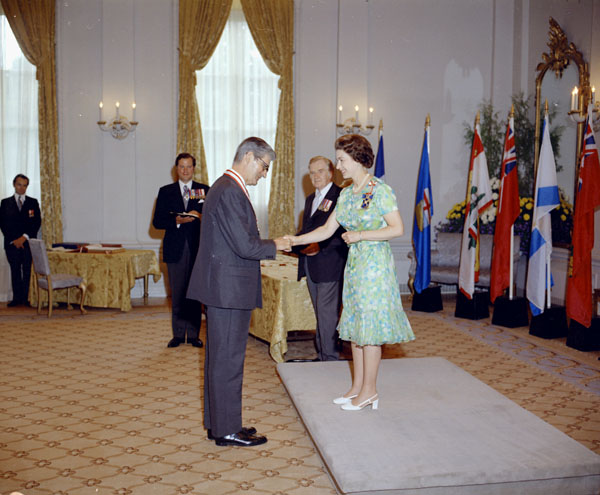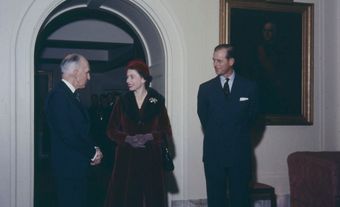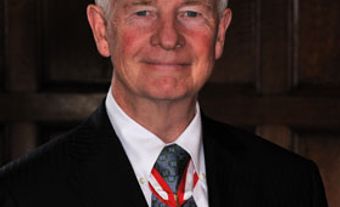
Early Life, Education and Family
Jules Léger was born on 4 April 1913 in Saint-Anicet, Quebec to Ernest, a postmaster, and Alda (née Beauvais) Léger, a storekeeper. Jules’ brother, Paul-Émile Léger, became a cardinal in the Roman Catholic Church. Jules Léger described Saint-Anicet as a place where everyone “lived and worked together as good neighbours,” no matter their heritage or mother tongue.
He studied at Collège de Valleyfield and at the Université de Montréal, where he completed a law degree. His thesis on the history of French Canadian literature earned him a doctorate from the Sorbonne university in Paris in 1938. That same year, Léger married Gabrielle Carmel whom he had met in Paris. The couple had two daughters, Francine and Helene.
Diplomat
After returning to Canada from his studies in Paris, Léger worked for one year as an associate editor for the newspaper Le Droit in Ottawa, and from 1939 to 1942 taught the history of diplomacy at the University of Ottawa before embarking on a diplomatic career of his own. He later noted that his diplomatic career gave him “a sense both of the relativity of facts and of the universality of man.”
While continuing to teach, he joined the Department of External Affairs in 1940. After a stint working in the office of Prime Minister William Lyon Mackenzie King, Léger was posted to Chile from 1943 to 1947. In 1949 he became executive assistant to Prime Minister Louis St. Laurent. Four years later, he was appointed ambassador to Mexico, the youngest Canadian to hold such a post. In 1954 he was promoted to under-secretary of state for External Affairs.
In 1958 Léger was made ambassador and permanent representative to the North Atlantic Council, and Canadian representative to the Organization for European Economic Co-operation in Paris. Four years later, he was named ambassador to Italy and in 1964 ambassador to France. In a 1965 documentary on CBC, Léger looked back on his life in Paris as his happiest posting because it marked a return to his student roots. He contrasted his student days when he couldn’t afford a taxi, to his being an ambassador “who can’t afford walking because he is provided with a car and a driver. So I try to walk as much as possible to remind me of my student days and the human contact that can be created merely by being close to people.”
His later years as ambassador to France, however, came during a difficult period in relations between the two countries. In 1967, while on a visit to Canada, French president Charles de Gaulle made his controversial “Vive le Québec libre” speech from Montreal’s City Hall. Léger would later win praise for his deft handling of the diplomatic crisis and its aftermath as relations between Ottawa and Paris cooled following the incident.
Léger returned to Ottawa and served again as under-secretary of state for External Affairs from 1968-72. During this time played a role in developing the foreign policy of Prime Minister Lester Pearson and the bilingualism and multiculturalism policy of Prime Minister Pierre Trudeau. Léger said the position helped him “evolve national policies designed to ensure that our two official languages could truly thrive.”

Governor General
Léger served briefly as ambassador to Belgium and Luxembourg in 1973, but in October that year was appointed governor general to succeed Roland Michener. Léger was installed on 14 January 1974 at a swearing-in ceremony in which he decided to forego the traditional military uniform worn by the governor general. During his investiture he described Canada as an “unfinished tapestry,” but was sometimes pessimistic about the county's future:
“We find ourselves in another age, whose contours we cannot fully perceive,” he said. “Our western civilization is floundering, exhausted, because of a number of paralyzing contradictions ... insecurity amid plenty; poverty amid wealth; a traditional morality that is being shaken and replaced by a yearning for primitive purity; acts of violence by some who shun violence; space-age communications at a time when major political groupings are tending more and more towards regionalism.”
A few weeks after moving into Rideau Hall, Léger ordered that all signs on the grounds of the residence be bilingual instead of English only. He also instructed that all RCMP guards at the residence be bilingual. In June, only five months after becoming governor general, Léger suffered a stroke while at the Université de Sherbrooke, where he was to receive an honorary degree. The stroke impaired his speech and paralyzed his left arm. He had to relearn French and English.
In December, Léger resumed his duties by presiding over an investiture of the Order of Canada. Although he regained a degree of health, he required enormous assistance from his wife, Gabrielle. She stood in for him at some events and helped him in various duties, such as reading part of the Speech from the Throne in 1976 and 1978. She was also actively involved in the restoration project of La Citadelle, the governor general's official residence in Quebec, after a fire in 1976 destroyed several rooms. Gabrielle’s contributions were recognized by her inclusion in Léger's official portrait, making her the only spouse to have been featured in a governor general’s portrait. Léger later said that if not for the stroke, he would have been able to accomplish much more as governor general.
Modernizing the Vice Regal Office
Léger travelled the country extensively during his term during a period in which Canada was divided by acrimonious disputes over the possibility of Quebec separation and the alienation of other regions. In one incident, during a 1977 concert by Quebec singer Monique Leyrac at the National Arts Centre, several people remained seated when Léger and his wife entered the royal box, and booed when the orchestra played portions of “God Save the Queen” and “O Canada.”
Throughout his term Léger maintained a serene confidence in the unity of Canada and inspired a renewed respect for his office. He sought to Canadianize the position and in 1978 became the first governor general to accredit diplomats to Canada and to sign treaties on the Queen's behalf. Léger is credited with modernizing the governor general's dress code. He became the first to wear the less formal "morning dress" at state functions rather than the traditional court dress of the elaborate Windsor uniform. His moves to reduce the position’s traditional British pomp and ceremony garnered some criticism.
The Légers were good friends of such artists as Jean Paul Lemieux, Alfred Pellan and Jean Dallaire. They filled Rideau Hall with the works of these and other artists and encouraged Canadians to come see the artwork.
In 1978 he established the Jules Léger Prize for new chamber music, which encourages Canadian composers to create avant-garde chamber music and to foster its performance by Canadian chamber groups. The following year, the Canadian government established the Jules and Gabrielle Léger Fellowship, awarded to outstanding Canadian scholars for research and writing on the role, function and historical contributions of the Crown and its representatives in Canada.
Retirement and Death
After leaving Rideau Hall in 1979, the Légers continued to live in Ottawa. Léger died on 22 November 1980.
Through a special act of Parliament in 1981, the government established the Jules and Paul-Émile Léger Foundation to honour the former governor general and his brother. The foundation supports innovative community-based initiatives in Quebec and around the world to improve the well-being of vulnerable and marginalized persons.
In 1982, the library at the headquarters of the Department of External Affairs’ (now Global Affairs Canada) in the Lester B. Pearson Building in Ottawa, was named The Jules Léger Library in his honour. His personal book collection, donated to the library by his widow, is housed as a separate collection in the library.

 Share on Facebook
Share on Facebook Share on X
Share on X Share by Email
Share by Email Share on Google Classroom
Share on Google Classroom



